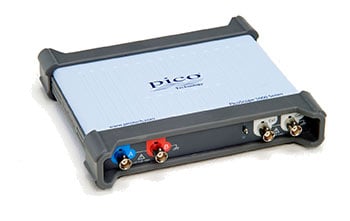PicoScope 7 Software
Available on Windows, Mac and Linux
PicoScope® 5000 Series
FlexRes® Oscilloscopes
High speed and high resolution. Breakthrough ADC technology switches from 8 to 16 bits in the same oscilloscope.


PicoScope software dedicates almost all of the display area to the waveform so that you can see the maximum amount of data at once. The viewing area is much bigger and of a higher resolution than that of a traditional benchtop scope.
With such a large display area, you can also create a customizable split-screen display, and view multiple channels or different views of the same signal at the same time. As the example shows, the software can even show multiple oscilloscope and spectrum analyzer traces at once. Each waveform works with individual zoom, pan, and filter settings for ultimate flexibility.
The PicoScope software can be controlled by mouse, touchscreen or keyboard shortcuts.

On many oscilloscopes, waveform math just means simple calculations such as A+B. With a PicoScope it means much more.
With PicoScope software, you can select simple functions such as addition and inversion, or open the equation editor to create complex functions involving filters (lowpass, highpass, bandpass and bandstop filters), trigonometry, exponentials, logarithms, statistics, integrals and derivatives.
Waveform math also allows you to plot live signals alongside historic peak, averaged or filtered waveforms.
You can also use math channels to reveal new details in complex signals. For example, you can graph the changing duty cycle or frequency of a signal over time.

The custom probes feature allows you to correct for gain, attenuation, offsets and nonlinearities in probes, sensors or transducers that you connect to the oscilloscope. This could be used to scale the output of a current probe so that it correctly displays amperes. A more advanced use would be to scale the output of a nonlinear temperature sensor using the table lookup function.
Definitions for standard Pico-supplied oscilloscope probes and current clamps are included. User-created probes may be saved for later use.
More information on Custom probes in PicoScope oscilloscope software >>

You can program PicoScope to execute actions when it detects events such as mask limit failures, triggers and buffers full.
PicoScope’s actions include saving a file, playing a sound, executing a program or triggering the arbitrary waveform generator.
Alarms, coupled with mask limit testing, help create a powerful and time-saving waveform monitoring tool. Capture a known good signal, generate a mask around it and then use the alarms to automatically save any waveform (complete with a timestamp) that does not meet your specifications.
Your PicoScope is provided with many powerful tools to help you acquire and analyze waveforms. While these tools can be used on their own, the real power of PicoScope lies in the way they have been designed to work together.
As an example, the rapid trigger mode allows you to collect 10,000 waveforms in a few milliseconds with minimal dead time between them. Manually searching through these waveforms would be time-consuming, so just pick a waveform you are happy with and let the mask tools scan through for you. When done, the measurements will tell you how many have failed and the buffer navigator allows you to hide the good waveforms and just display the problem ones. This video shows you how.
Perhaps instead you want to plot changing duty cycle as a graph? How about outputting a waveform from the AWG and also automatically saving the waveform to disk when a trigger condition is met? With the power of PicoScope the possibilities are almost endless.